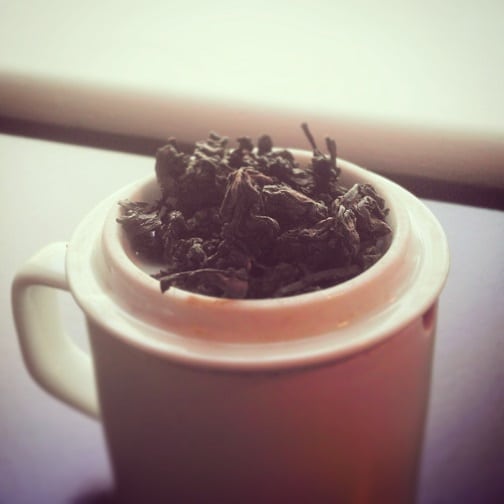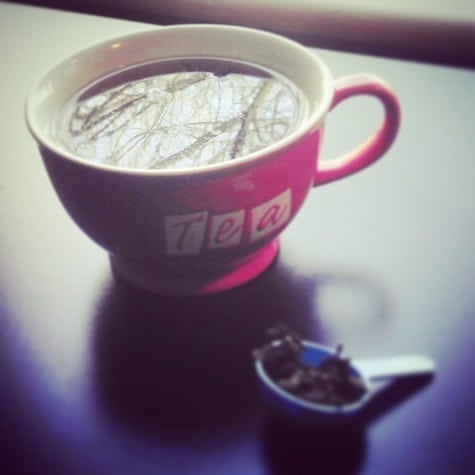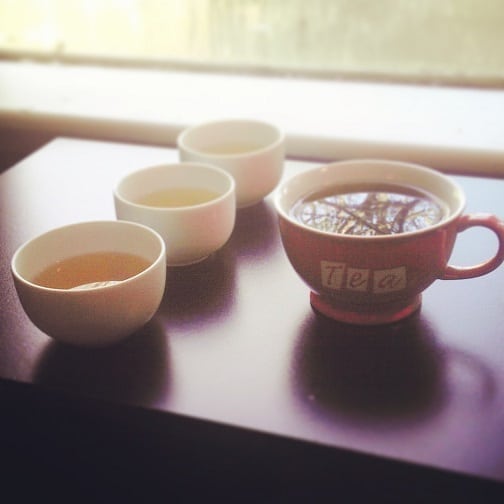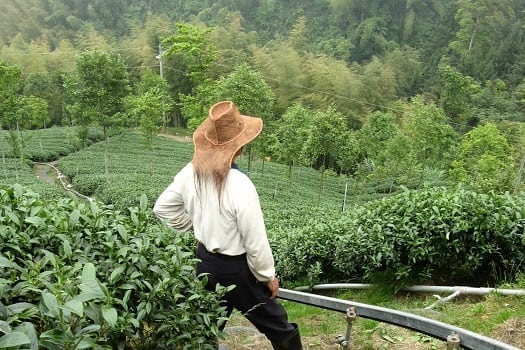The late Bob Ross used to close his show with the line, “There are no mistakes, only happy accidents.”

His philosophy – if it can be called that – holds true for a lot of things. Oolong, for starters, was a happy accident. As legend has it, the style came about because a leaf picker fell asleep, allowing the leaves to partially oxidize. Taiwanese aged oolong was a happy accident. Someone once thought, “Hey, why don’t we sit on this back stock of tea for a few years and see what happens.” Lapsang Souchong . . . well . . . I think I’ve covered that subject aplenty.
Point being, while the Ross-ite “happy accident” logic doesn’t hold true for all things, it does for a lot of things, especially in the tea world. I just never thought I would run into one in my pursuit of weird teas. This one practically fell into my lap.
I received an e-mail from Eco-Cha, a relatively new outfit. The name “Eco-Cha” in Chinese literally translates to, “A Sip of Tea”. The company was the brainchild of Andy Kincart, Tom Lin and Nick Fothergill – all of whom had lived in Taiwan for a number of years. Advisory support was provided by Tony and Lisa Lin, renowned proponents of Taiwanese tea culture. Their mission was simple, source and sell Taiwanese oolong tea directly to the consumer.
Occasionally, however, they sourced the odd black tea or two. One in particular hailed from the Shan Lin Xi district in Nantou county, Taiwan – a relatively high altitude tea growing region. The name Shan Lin Xi translated to “Pine Forest Stream”, and was also home to the famous oolong of the same name. Many farmers in the region have been at the tea growing game for several decades . . . including this guy.
(I have no clue who he is.)
In winter of 2012, after tea leaves had been plucked and fried, they were brought indoors to oxidize. They were stored on multiple racks, one on top of the other. The tea master had inadvertently forgotten to check the top rack. (It was above eye level.) He didn’t realize this until the next day, after the leaves had undergone roughly 75% oxidation. The typical Shan Lin Xi oolong oxidation level is about 30%.
Instead of tossing the entire batch, the tea master adapted his rolling techniques to suit these accidental leaves. The result was a unique beast in the tea world often referred to as a “red oolong”. While it was still an oolong by technique, the mostly-oxidized profile gave it a black tea (or “red tea”) character. I had sampled red oolongs before, but those had been intentional. This was my first taste of a happy accident.

The leaves looked like a darker-roast, heavier oxidized version of almost every Taiwanese oolong I’ve ever come across. They were ball-fisted in appearance, and the color spectrum ran from forest green to cherry wood red. What was different, though, was that the actual leaf-rolling appeared incomplete. They weren’t as tightly rolled as others I’d come across before. As for fragrance, I was more reminded of other Taiwanese black teas – due to the sweeter aroma – but there was something different at play, too. A floral underpinning was also present amidst the sweetness.
Eco-Cha surprised me with some of their brewing recommendations. Aside from the usual gongfu (multiple short infusions) brewing instructions, they also recommended brewing this grandpa-style – putting leaves in a mug and pouring hot water over it. That gave me a grin . . . so, I did it both ways.
Brewed gongfu-style, the liquor color on each infusion gradually grew darker.

It started off pale, like a typical Taiwanese oolong, then grew slightly more crimson by the second, and a deep bronze by the third. Each steep had an aroma of sweetened nuts and a hint of fruit. That also showed up in the taste, revealing a complex combination of flavors and sensations. Like an oolong with darker – if mintier – aspirations
Grandpa-style, though . . . wow . . .

I didn’t have a 16oz. mug (that was clean) for taste-testing, so I utilized a 12oz. one. Unfortunately (and awesomely!), I kept the leaf ratio the same – roughly 2 teaspoons. The results were sheer brilliance – a bold, rust red-colored liquor with leaves at the bottom beckoning to surface. The aroma was like that of a Ruby 18; woody, minty, sweet, and slightly malty. Some astringency showed up the further down I sipped, but it helped bring a spry note to the sweeter proceedings. The further I sipped, the more it was like I was sipping cherry-filled chocolates that’d been left in the sun.
By the end of this Taiwanese double-fisting, I realized I was extremely wired. Not just any wired, but “Rainbow Fuzzy Buddha”-wired. Doesn’t make sense? Well, it didn’t to me, either. I hadn’t intended to have that much of this black tea in one sitting. Nor did I plan on re-steeping both helpings. My excuse? Another photograph.

Flimsy, I know.
Oh well, like this tea, the resulting warm fuzzy feeling was just a happy accident.







 I remember the first time I ever tried to pronounce the word “bergamot” in front of a bona fide tea professional. He instantly corrected me by saying, “It’s bergaMOT.” And here I was uttering the less pronounced, “bergamitt”. That’s the way it always looked to me.
I remember the first time I ever tried to pronounce the word “bergamot” in front of a bona fide tea professional. He instantly corrected me by saying, “It’s bergaMOT.” And here I was uttering the less pronounced, “bergamitt”. That’s the way it always looked to me.